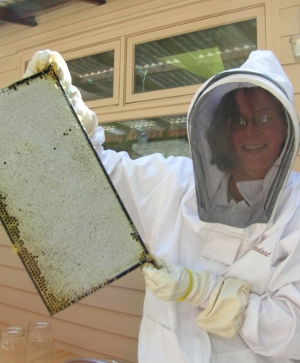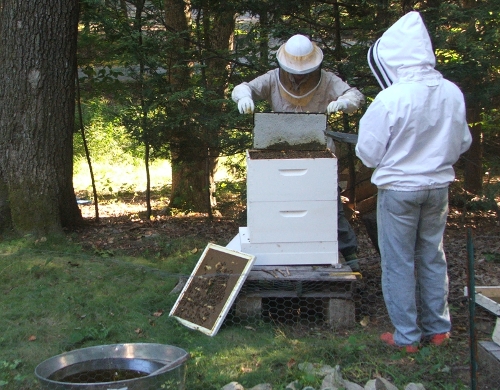When Tom (the hive inspector) pulled out one of the frames, he said it looked like perfectly good honey and I could harvest it.There would be another flush of nectar at the end of summer, so whatever I took they would easily rebuild and refill.
So yesterday I did just that.
The bees only got upset with me taking it when I started brushing off the 200 or so bees that were working on the frame. It was a quick job and I walked away with a clear frame within minutes. The point, I’ve found, with beekeeping is to set your goal, to go in and act resolutely and confidently, and leave things in order.
One side was entirely capped, the other had about 1/10 of uncapped honey on it. I harvested only the complete side – never harvest uncapped honey because the bees haven’t evaporated it enough and it will ferment your entire batch.
First I sliced/sawed) off the wax caps with a bread knife warmed in a glass of hot water (a serrated knife would have been better, in hindsight). I didn’t want to ruin the comb, so at first I set the frame at and angle and let it drip, but it was soon clear that I’d have to wait days to get enough honey out that way. During that time, the honey would soak up humidity from the air, making it unsuitable.
Letting go of my hopes to keep the comb intact, I pressed the comb with the back of a spoon. The wax of the cells is so fragile , it gave away almost immediately. I squeezed the honey out with the spoon, trying to keep as much wax out as possible. I transferred this honey into a fine mesh colander and let it drip through into a stainless steel pot. Then I scraped off the wax comb – I thought it would take the bees less time to rebuild it from scratch than to clean that mess and rebuild it. This mess still had a lot of honey in it, so I set that to drip in a different colander, for more immediate use, since it took longer to drip out than the first batch.
Altogether we collected 2 lbs. 1 oz. of gold!
Then I returned the frame – the other side completely untouched – to the hive. The bees weren’t happy but I came away with no injuries. My husband helped carry the tray with the frame. You have to be careful not to leave even one drop of honey on the outside of or anywhere near the hive, because this might attract other bees who will then rob the hive. This can seriously weaken even a strong colony. It’s a good thing I didn’t wait until today to return the frame because even after 4 hours the bees had already built a lot of bur comb and propolis into the gap.
It’s all for Amie – 1 teaspoon a day to combat her allergies – so I won’t be presenting friends and family with jars of liquid gold, yet. But, wow, 2 lbs off one side of a frame! A deep frame, to be sure, but still. When Tom said I could have 100 lbs next year, if all goes well, I was skeptical, but no longer.
How does it taste?
Mmmmm. Incomparable!






That looks fantastic, well worth all the effort you’ve put into it!
This is so exciting! Congratulations on your first honey harvest. I hear local honey helps with allergies tremendously. So nice to have a pleasant tasting “medicine.”
I’ve also kept bees off and on. templeterracegarden – they’re not at all asrgegsive, except when jostled or in bad weather – my kids played in the yard within 15 feet from the hives and were never stung (except when walking barefoot over clover!).I need to get some again. All the parts from two hives are waiting in my barn. You’re lucky to have them in the yard – my pear trees were LOADED back when I had a hive going.
We estimate that the hive of bees would be 1,200 bees. We found this aneswr by counting 1/4 of the picture. We found that there were 70 bees in 1/4 of the picture. We added 70+70+70+70=280 bees. Then we rounded 280 to 300 bees. Next we knew that 300 was just 1/4 of the entire bee hive. So we multiplied 300 4=1,200 bees in the bee hive. We are so glad that we did not have to count 1,200 bees! Thank goodness we know how to estimate!Mrs. Martel’s 2nd & 3rd graders